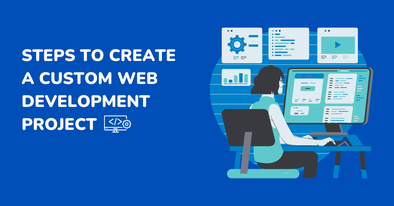Steps to Create a Custom Web Development Project

The number of websites on the web exceeds 1.6 billion today. The journey that you have to take to make your way up must be one of the best. There’s no need to worry, because by the time you finish reading this article, several thousand other sites will be up as well. In this sense, it can be said that building an effective, full-featured, out of the box website is an amalgamation of numerous processes as they take place behind the scenes.
In terms of technologies, CSS, HTML, and JavaScript make up the face of a website, but they are just a tool. Information integration, detailed planning, and post-launch maintenance are key to any web development project. In order for a website to be considered an ideal one, it must be suitable for your audience and distinguish itself from the competition.
In most cases, websites are struggling either because they are outdated or because they do not align with the purpose of the website. In this article, we will discuss how web development project plans can be created. The first step in this process is to set goals.
Your website should have a clearly defined objective if you want it to be successful. A website can either be created for general purposes such as generating interest, or it can be created for very specific purposes such as increasing online revenue. Never forget that web design isn’t just about programming. Take a look at the whole process in detail.
Important Steps for a Web Development Project Plan
1. Establishing the goal of the development project
This is the very first step in the development process. This usually involves gathering information and making research discoveries about the project. As part of this step, you will determine whether you need to learn about the client’s industry, product, targeted market, customers, or the overall purpose and intent of the website. As far as developing the correct website according to the needs of a client is concerned, the process of gathering information plays a key role. The most frequently asked questions include:
1. Which of my competitors am I going to face?
2. Where will your ideal clients come from?
3. How will you define your company or organization?
4. What are the objectives of the website?
5. What are the specific concepts/services that the website is promoting/offering?
After you have discovered and gathered information, only then can you proceed with dedicated web development to achieve your personal and professional goals. Decide what the website’s purpose is! It doesn’t matter if you’re trying to sell a product, offer a service, or simply share information.
2. Create a timeline for your site.
A common denominator among all successful projects is a dedicated timeline. An absence of a timeline may result in a project never finishing. A clear schedule should be established for starting an in-house or outsourcing web development project and for completing it within a specified number of days. PowerPoint timeline templates can prove useful in this situation. You can even use the PowerPoint timeline template when developing a custom web project plan for someone else.
Consider strategic dates, or days that may serve an added advantage, when picking the dates for the project timeline. It is very important to take into account your own capacity to manage and guide the project. Keeping your timeline flexible for self-explanatory reasons may be necessary if you are consulting with experts from other fields for your project.
3. Identifying the Audience.
Knowing well about your audience is paramount when working on an online web development project. Think about basic questions like, does the site have a specific demographic or is it intended for a general audience? Keeping those examples in mind, not every website is suitable for every kind of visitor. An example of this is the difference between a website for a coffee shop and one for a financial institution.
It is important to look at accessibility concerns from the audience’s perspective, such as the fact that there are an increasing number of people visiting websites on smartphones and very few older computers. A good strategy can only be set up when you have a clear understanding of who your audience is. It is important that the design, content, and overall aesthetics of your website relate to your audience if you are to develop an attractive website.
4. Optimizing your website for search engines (SEO)
There are usually two reasons why websites fail: they are outdated or they don’t align with their intended purpose & keyword research. In order to achieve high ranking and cost-effective results, a content strategy is developed to incorporate deep into different elements of the website.
During Search Engine Optimization (SEO) a domain name, the root structure of the website, metadata, and other portions of the website are integrated with rich content. A new web project is generally developed from a functional perspective by individuals and even by organizations. Most people are only concerned about the look and feel of the site since they are not well-versed in SEO practices. You can boost the results of your web development project and boost the performance of the project in a large way by creating and integrating a dedicated search engine optimization (SEO) strategy.
5. Sitemap for your website
It is time to put all the dots together and connect them for your website after collecting all the relevant information in the first phase. In other words, this is the point where the map of a site begins to appear. Site maps are nothing more than lists of all the main topic areas and subtopic areas of the website. As part of the planning process, content is categorized by region and accordingly suited to that region.
Only then can it be easy to comprehend how site navigation can be designed. During the web development project stage, the end-user, that is your customer or user, should always be kept in mind. Because they will be using the website to learn, buy products, and use services, it should be user-friendly and include an easy-to-use interface.
6. Website Development Design.
Let’s decide how the website looks and feels. Target audiences will play a significant role in this decision. Obviously, not all audiences will be the same. However, you can keep the website design the same for different kinds of audiences. Designing for your target audience is incredibly important. Your site’s identity is reinforced by the use of colour schemes, logos, and other visual components.
Up until now, there has been very little programming in the web development process. A JPEG image or PowerPoint infographic is usually used to create multiple prototypes for a website. As the final design of the website is achieved, changes are made to the prototype template/image. A detailed review of the site content should be conducted. Form and function should be balanced in a good website. Once this is achieved, web development can begin.
7. Build
A project begins when the design is completed and the project is ready for development. It is then possible to translate the website to actual code that can be transformed into a reality, making the design in slides a reality. As soon as the prototype is completed, the actual functional website will be built in sync with what has been developed in the prototype.
Developing a home page prior to developing interior pages is a recommended practice. Because it is important to ensure the user-friendliness of the site’s navigation at all times, this practice can prove beneficial. It is possible to distribute the content, after setting up a website page, inside and outside of the site in appropriate areas. Designing and developing a website takes a lot of dedication and time. Nevertheless, if you’re a designer or a developer, you can certainly make it work. In the event that you are not able to accomplish the job on your own, you may want to consider hiring a professional to do the job for you while you focus on the project goal itself.
8. Evaluation & Review
A web development project isn’t complete until the testing stage has been completed. The site is tested before deployment and final touches are made to it.
All components of the site are being tested now in order to ensure that the site runs smoothly. If there are bugs or glitches, it should be rectified immediately. Scripts, forums, platforms, and devices are all verified to ensure data integrity across all pages, databases, and devices.
Furthermore, website code is checked to ensure it meets the latest website standards. The site stays up and running without giving any trouble to any kind of visitor. As soon as the testing and review have been completed, the launch will take place.
9. Project launch for Web Development
If all goes well after testing and site review, the website is ready for the world to see. It is now time for the official launch. FTP (File Transfer Protocol) software is used to upload the site to a server. The domain name is now accessible via its official website. Maintenance of the site is the final component of the whole plan.
To remain successful and healthy in the long run, a website must be maintained. Maintaining your website is just like maintaining your car. Regularly updating the content of your website is important. Installing security patches is also important from time to time.
Conclusions
Hope this guide turned out to be helpful to you. If you have any questions or something to include, feel free to let me know in the comments.




